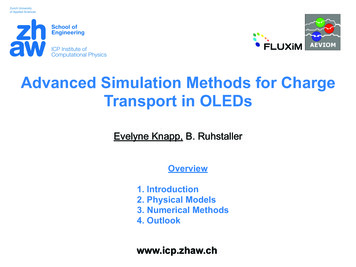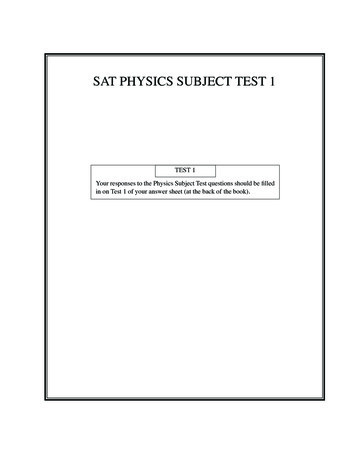
Transcription
FLUXiMAdvanced Simulation Methods for ChargeTransport in OLEDsEvelyne Knapp, B. RuhstallerOverview1. Introduction2. Physical Models3. Numerical Methods4. Outlookwww.icp.zhaw.ch
ICP Team Interdisciplinary team of 8 physicists,4 mathematicians und 3 engineers1996 Section NMSA2002 Foundation CCP2007 Foundation ICPInstitute of Computational PhysicsSpin-offs:Numerical Modeling GmbH, www.nmtec.chFluxim AG, www.fluxim.com
Research Activities The main focus is applied research anddevelopment in the following areas:››››Micro systems, sensors, actorsFuel cellsOrganic optoelectronic and photovoltaicsSimulation softwareInstitute of Computational Physics
AEVIOMAdvanced Experimentally Validated OLED modelPhilips Research EindhovenProject Coordinator:Reinder CoehoornEindhoven University of TechnologyPhilips Research AachenZürich University of Applied SciencesFluximTechnical University DresdenSim4TecUniversity of GroningenInstitute of Computational PhysicsUniversity of Cambridge
Principle of OLED Operation2Xh!"Fundamental Processes:41. Charge Injection2. Charge Carrier Transport3. Exciton Formation4. Radiative Decay5. Light ctron Cathodetransportlayer(ETL)Real stack consists of up to 12 layers!Institute of Computational Physics
Simulation of Organic LEDsLUMO!Cathode!Anode!HOMO! Novel physical models require better numerical methods Transient simulations and IV curves need multiple simulations Efficient simulations are crucialExperimental data from CSEM, simulation by ICPInstitute of Computational Physics
Overview-Task list Modeling of charge carrier transport› Gummel solver› Newton solver Bipolar Injection Organic material properties› Disorder (Gaussian DOS)› Mobility› Generalized Einstein relation Traps (Exponential DOS) Multilayer OLEDs Exciton dynamicsParameter extractionCoupling to optical model Impedance simulationsInstitute of Computational Physics
Organic MaterialsGaussian DisorderEnergyLUMOLUMOHOMOHOMO Small molecules and polymerLEDs/solar cells Charge transport by hoppingbetween uncorrelated sites Width of DOS-disorder parameterσ (50-150 meV)DOS! "#2 Nt! !0DOS(!) exp 2πσ2σInstitute of Computational Physics
Governing Equations in OLEDsPoisson equation:! ψ q(n p)Continuity equation: p · Jp q qR(p, n) tDrift-Diffusion:Jp qµp p ψ qDp psimilar for electronsInstitute of Computational Physics
Governing Equations in OLEDsPoisson equation:! ψ q(n p)Continuity equation: p · Jp q qR(p, n) tDrift-Diffusion:Jp qµp p ψ qDp psimilar for electronsmobility&diffusion coefficientare affected by the Gaussian DOS!Institute of Computational Physics
Generalized Einstein RelationEp ! DOS(E)f (E)dE ordered materialDOS EStatisticsBoltzmannEinstein relationDkT µqDOS(E), f(E)Institute of Computational Physics
Generalized Einstein RelationEp ! DOS(E)f (E)dE ordered materialDOS i-DiracEinstein relationDkT µqDp pµq EFDOS(E), f(E)Institute of Computational Physics
Generalized Einstein RelationEp ! DOS(E)f (E)dE ordered materialDOS i-DiracEinstein relationDkT µqDp pµq EFDOS(E), f(E)Institute of Computational Physics
Extended Gaussian DisorderModel (EGDM)kB TDp µ0 (T, p, F )g3 (p, T )qµp (T, p, F ) µ0 (T )g1 (p, T )g2 (F, T )g2 (F, T )g1 (p, T )g3 (p, T )Nonlinear equations for mobility and diffusion coefficientMobility depends on temperature, field and densityInstitute of Computational PhysicsS. L. M. van Mensfoort, R. Coehoorn, Phys. Rev. B 78,085207 (2008)
Effects of EGDM Transport(%&' !field [V m -1]organic materialCathodeAnode"# !! constant!#!"!n1 0.5Ntn2 0.5Nt16V!(&!relative carrier densityAssumption of ohmic contact:Dirichlet boundary conditions)* ,-(& (.!&&!!"&!!'&!!#&! (!"!#! !device [nm]Institute of Computational Physics%!&!!
Effects of EGDM Transport(%&' !field [V m -1]organic materialCathodeAnode"# !! !#field dependent!"!n1 0.5Ntn2 0.5Nt16V!(&!relative carrier densityAssumption of ohmic contact:Dirichlet boundary conditions)* ,-(& (./"(& (.!&&!!"&!!'&!!#&! (!"!#! !device [nm]Institute of Computational Physics%!&!!
Effects of EGDM Transport(%&' !field [V m -1]organic materialCathodeAnode"# !! !#density dependent!"!n1 0.5Ntn2 0.5Nt16V!(&!relative carrier densityAssumption of ohmic contact:Dirichlet boundary conditions)* ,-(& (./"(& (./&(& .!&&!!"&!!'&!!#&! (!"!#! !device [nm]Institute of Computational Physics%!&!!
Effects of EGDM Transport(%&' !field [V m -1]organic materialCathodeAnode"# !! EGDM!#!"!n1 0.5Ntn2 0.5Nt16V!(&!relative carrier densityAssumption of ohmic contact:Dirichlet boundary conditions)* ,-(& (./"(& (./&(& .0123(& (.!&&!!"&!!'&!!#&! (!"!#! !device [nm]Institute of Computational Physics%!&!!
EGDM on single layer OLEDIV Curve(hole-only device)IV Curve(hole-only device with 1eV built-inpotential)%&'()* ,'-./0'&2!,&1.!"!" 9)**,:/';,: ./ '7 ?@#8!"σ 6kB T"!"! σ 3kB T!"!!"!"!#!"!!"!"!"!!" 34/56,'7&8 Diffusion effectsField- and density-dependentInstitute of Computational Physics Effects of different disorder parametersIn good agreement with:S. L. M. van Mensfoort, R. Coehoorn, Phys. Rev. B 78,085207 (2008, Fig 9)
Recombination Profiles10 V1.41.61.2normalized recombination ratenormalized recombination rate3V1.81.41.210.80.6const! 3! 60.40.2000.20.40.6device [m]0.81 7x 1010.80.60.4const! 3! 60.2000.20.40.6device [m]0.8 Bipolar simulation with constant mobility and EGDM for σ̂ 3 and Effects of disorder clearly visibleInstitute of Computational Physics1 7x 10σ̂ 6
Thermionic InjectionmetalorganicLUMOΦeFermi energyworkfunctionContact RegionInstitute of Computational Physics
Thermionic InjectionmetalorganicΦimageLUMOΦeFermi energyworkfunctionContact RegionInstitute of Computational Physicse2 1 16π""0 x
Thermionic InjectionmetalorganicΦimageLUMOΦeqExFermi energyworkfunctionContact RegionInstitute of Computational Physicse2 1 16π""0 x
Thermionic InjectionmetalorganicLUMOΦeΦBFermi energyworkfunctione2Φe eEx 16π""0 xInstitute of Computational Physics
Thermionic InjectionmetalorganicmetalorganicLUMOe-!!nFermi Energy/WorkfunctionDensity at contact depends on position of Gaussian DOSDependent boundary conditionsInstitute of Computational Physics
Effects of InjectionDependence of the currentdensity on the injection barrierat 2V No effect if injection barrier 0.5 eVHigher currents with image potentialAgrees with Monte Carlo resultsInstitute of Computational PhysicsIn good agreement with:J.J.M. van der Holst, M.A. Uijttewaal, R. Balasubramanian, R.Coehoorn, P.A. Bobbert, G.A. de Wijs and R.A. de Groot (EUT,PRE), Phys. Rev. B (2009).
Y OF TRAPS Traps are considered as energy states that are within the energywhen an electric field is applied carriers in trap stay stationary and have aprobability. After successfully fitting IV-curves in case of hole transport forthe model does not describe the behaviour of electron transport correctly asby the presence of traps. The trapped electrons do not contribute to thetherefore a lower current is obtained as the electrons are captured temporarilyp states. In this paper traps are taken into account when modeling electronhe densitystates (DOS)is describedas a superpositionofaffinitya Gaussian DOS of2 localizedsiteswith higherelectronNt,eEEtexp ( kT) which includesexp ( 2σ2 ) and an exponential DOS g(E) kT00πσ 2›impurities,chemicaldefectses as explained in (12). The field and density dependent mobility is adaptedian part of thedensity of states. In Fig. the total density and its componentsModeld. However the values to not correspond to realistic parameters and are only› n. Theexponentialpart symbolizesthe trap distributionwhile theers are in the Gaussian. Depending on the parameters that describe the DOSdiscretelevels:shallow,deepbe neglected or havemi energy the ›presenceof trapsfor electronscan almostuence. The EGDM is applied to the free movable electrons while the trappedTrap Effects in OLEDsexponential DOSGaussian DOStotal DOS! ψ q(n p nt pt )DOS · Jp q p qR(p, n) tJp qµp p ψ qDp penergytion of DOS. The exponential DOS represents the trap states while the Gaussianile carriers.Theyup to the totalDOS.Instituteof addComputationalPhysics
Trap IV Curves !'(/01213452674637!"!"&!"" !%"!"!#!"m 1 !"! !"!%!"!"m 8.1m 2'()'*"% !"trap density influences current densityAnalytical solution for Gaussian DOS:M. M. Mandoc, B. de Boer, G. Paasch, P. W. M. Blom, Phys. Rev. B(2007).Institute of Computational Physics
Multi-layer Devices Stack of organic material to optimize recombination profiles and lightemissionInstitute of Computational Physics
Spatial Discretization 1-dimensional finite volume method› Domain divided into n grid pointsAnode CathodeReformulation of problem!F1 (ψ, p, n) " ψ q(n p) 0 p! qR 0 t n! qR 0F3 (ψ, p, n) · ( qµn n ψ qDn n) q tF2 (ψ, p, n) · ( qµp p ψ qDp p) q Integration over each boxInstitute of Computational Physics
Scharfetter-GummelDiscretization Neglecting recombination and assuming a constant current density throughthe device Boundary values Analytic solution Analytic solution serves as Ansatz function› Scharfetter-Gummel discretizationInstitute of Computational Physicsand
Spatial Discretization Exponential fitting for drift-diffusion (F2 and F3)› Scharfetter-Gummel discretization with generalized Einstein relationand density- and fielddependent mobility System of (3 x n) strongly coupled equations ! F1 (!x)F! (!x) F!2 (!x) F!3 (!x) ψ1 : ψ n n1 !x : nn p1 : pnDirichlet boundary conditions:› Values for potential and carriers given at electrodesInstitute of Computational Physics
Problem Formulation Variables sets› carrier concentrations (ψ, p, n)› quasi-Fermi level (ψ, φp , φn ) Assumption: Boltzmann statistics !"q(φp ψ)p nint,ef f expkT!"q(ψ φn )n nint,ef f expkT› Slotboom (ψ, Φp , Φn )Φp expΦn expInstitute of Computational Physics!!qφpkT" qφnkT"p pi Φp exp!n ni Φn exp qψkT!qψkT""
Discretized Equations De-coupled solvingF3› Gummel algorithmF2F1 Coupled solving› Newton algorithmFind x* so that F(x*) 0.F(x) F(x * ) J(x * )(x " x * ) #F1 (x)#F1 (x) '!& #x#x N )1&)J(x) & "#" )& #FN (x) ! #FN (x) )#x N )(&% #x1* x k 1 x k " J(x k )"1 F(x k )Institute of Computational PhysicsF1Taylor SeriesF2F3Jacobian MatrixIteration function}}
Algorithms Gummel› steady-state› transient Newton› steady-state› transientInitial guess› no bias applied, Boltzmann approximationGummel steady-state› DampingNewton› Damping› Homotopy Institute of Computational Physics
Convergence - Steady State!" n" L2-Norm: F # Fk 2k 1!./00,*01)*23,45'!1-72341 7 ,9,45 ?)@!('!!'!'!1!!"#!" !"%)* ,-*!"&'#!1 !'&*23&43*)0-5662)*23,4516078,9*1/41!":&;%&'()* )',)!Gummel!"Newton#!!#!#!!#"#!! !#!Institute of Computational Physics!"#!-.)*/.-&'0#" !
Convergence - Steady State!" n" L2-Norm: F # Fk 2k 1!./00,*01)*23,45'!1-72341 7 ,9,45 ?)@!('!!'!'!1!!"#!" !"%)* ,-*!"&'/#!- ! *(./*0/(',%122.)*23,4516078,9*1/41!":&;3* 4'(5' 6'#!Gummel"Newton#!!#!!"#!!#!#! /!"#!%&'()&%* ,Convergence for Gummel and Newton algorithmFewer iterations needed for Newton algorithmInstitute of Computational Physics#" !
Transient Simulations Implicit Euler time stepInstitute of Computational Physics
Outlook Modeling of charge carrier transport› Gummel solver› Newton solver Bipolar Injection Organic material properties› Disorder (Gaussian DOS)› Mobility› Generalized Einstein relation Traps (Exponential DOS) Multilayer OLEDs Exciton dynamicsParameter extractionCoupling to optical model Impedance simulationsInstitute of Computational Physics
Exciton Dynamics !Poisson Equation !Charge Current !Charge Continuity ! !Exciton CurrentExciton Continuity !Light-emission (from dipoles) &Light-incouplingElectro-optical Coupling TermsOpto-electronic Coupling TermsExtended version of the models published by Ruhstaller et al., J. Appl. Phys. 89,4575, (2001) and Ruhstaller et al., IEEE JSTQE 9, (3) 723, (2003)Institute of Computational Physics
Outlook Modeling of charge carrier transport (1st generation)› Gummel› Newton Bipolar (1st generation) Injection (2nd generation) Organic material properties› Disorder (2nd generation)› Mobility (2n generation)› Generalized Einstein relation (2nd generation) Traps (2nd generation) Multilayer OLEDs (1st generation) Exciton dynamics (1st generation)Parameter extractionOptical simulations Impedance simulationsInstitute of Computational Physics
Acknowledgement We acknowledge the financial support of RF7 Thanks for your attention!Institute of Computational Physics
FLUXiM Advanced Simulation Methods for Charge Transport in OLEDs Evelyne Knapp, B. Ruhstaller www.icp.zhaw.ch Overview 1. Introduction 2. Physical Models










